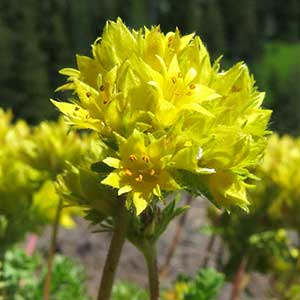Ivesia gordonii
Ivesia unguiculata
alpine ivesia, alpine mousetail, Gordon's ivesia
Yosemite ivesia, Yosemite mousetail
prostrate to erect, (0.2–)0.5–4 dm.
decumbent to ascending, 1–3.5 dm.
tightly to loosely cylindric, (1–)3–20(–25) cm; sheathing base ± glandular abaxially, otherwise glabrous;
petiole 0.5–8 cm, hairs 0.2–0.5 mm;
leaflets (6–)10–25 per side, (1–)2–13(–18) mm, glabrous or ± hirsute or villous, glandular-puberulent or -pubescent, lobes (2–)4–8(–15), linear or narrowly oblanceolate to obovate, apex rarely setose.
(4–)7–15 cm; sheathing base ± glabrous abaxially;
stipules linear, 3–6 mm;
petiole (0.3–)0.5–4(–5) cm, hairs sparse to abundant, ascending to spreading, 1–2 mm;
leaflets 15–20(–25) per side, loosely overlapping, 3–6 mm, lobes 3–8, linear to oblanceolate, hairs sparse to abundant, spreading, 1–2 mm.
1(–2), not paired.
3–6.
5–50(–70)-flowered, 1–8(–11) cm diam.;
glomerules 1–several.
(15–)30–100(–200)-flowered, (1–)1.5–4(–8) cm diam., flowers mostly arranged in 1–several loose to tight glomerules of 5–10 flowers.
1–3(–5) mm.
1–3 mm.
5–12 mm diam.;
epicalyx bractlets linear to narrowly elliptic, (0.5–)1–3.5(–4) mm;
hypanthium turbinate to campanulate, (1.5–)2–4(–4.5) × 2–4(–5) mm;
sepals (2–)2.5–5(–6) mm, obtuse to ± acute;
petals yellow, narrowly oblanceolate to narrowly spatulate, (1–)1.5–3 mm;
stamens 5, filaments 1.3–2.5 mm, anthers yellow, sometimes red-margined, 0.5–1 mm;
carpels (1–)2–4(–6), styles 2.5–4.5(–6) mm.
6–9 mm diam.;
epicalyx bractlets linear or narrowly lanceolate to elliptic or narrowly oblong, 1.2–2(–3) mm;
hypanthium shallowly turbinate, 1.5–2.5 × 2–3(–3.5) mm, often nearly as deep as wide;
sepals heavily purple-mottled, (1.5–)2–3(–3.5) mm, acute;
petals white, often tinged with pink, oblanceolate to spatulate or obovate, 3–4 mm;
stamens 10–15, filaments filiform, 0.6–1.1 mm, anthers maroon, 0.3–0.5 mm;
carpels (1–)3–9, styles 1.4–2 mm.
grayish brown to mottled brown, ± 2 mm.
light brown, 1.2–1.5 mm.
Ivesia gordonii
Ivesia unguiculata
Varieties 4 (4 in the flora).
Ivesia gordonii is the most widespread species of the genus, occurring from Washington to Montana, south to central California and Colorado. The species can be distinguished from other members of sect. Ivesia by the relatively deep hypanthium, which is about as deep as wide. Four varieties are provisionally recognized here (B. Ertter and J. L. Reveal 2007), with the likelihood that future work may indicate additional and/or alternate circumscriptions. Populations that are difficult to assign to a variety can be found where the recognizable taxonomic units come together, for example, in northeastern Utah and western Wyoming, involving var. gordonii and var. wasatchensis, and in California and central Idaho where var. alpicola and var. ursinorum tend to merge.
(Discussion copyrighted by Flora of North America; reprinted with permission.)
Of conservation concern.
Ivesia unguiculata is found in mid-elevation meadows of the central Sierra Nevada, mostly north of the Kings River. The distinctive deep red to purplish coloration of the inflorescence, and the plant in general, can make patches of this species conspicuous as a smoky purplish haze in meadows. The shape and color of the inflorescences are similar to those of the sympatric Horkelia fusca var. parviflora, suggesting shared pollinators.
The description and illustration by J. D. Hooker (1881), supposedly of Potentilla (Ivesia) unguiculata, were based actually on material grown from seed of I. sericoleuca due to initial confusion of the two species (W. H. Brewer et al. 1876–1880, vol. 1).
The type (Kellogg s.n., CAS) of Potentilla ciliata Greene (not Rafinesque) is unquestionably this species; however, the purported locality (Owens Valley, Inyo County) is dubious and most likely an error in the labeling of the specimen by the collector.
(Discussion copyrighted by Flora of North America; reprinted with permission.)
1. Leaflets 7–13(–18) mm, glabrous or sparsely hirsute or villous marginally; stems (1–)1.5–4 dm; inflorescences usually branched, 2–8(–11) cm diam., glomerules (1–)2–6(–10), ± capitate. | var. wasatchensis |
1. Leaflets (1–)2–7(–9) mm, hairy or ± glabrous except marginally ciliate; stems (0.2–)0.5–2.5 dm; inflorescences simple or branched, 1–3(–5) cm diam., glomerules 1(–3), ± capitate to loosely congested | → 2 |
2. Stems usually prostrate to ascending, rarely nearly erect, usually dark reddish, minutely glandular or glandular-puberulent to -pubescent; leaves to 0.8 cm diam.; anthers usually red-margined. | var. ursinorum |
2. Stems usually ascending to erect, sometimes decumbent, usually greenish, rarely reddish, hirsute to villous, glandular-puberulent to -pubescent; leaves to 1.5 cm diam.; anthers rarely red-margined | → 3 |
3. Stems usually hirsute to villous, sometimes densely so, glandular-pubescent or eglandular; basal leaves (3–)5–10(–15) cm; flowers 7–12 mm diam.; e Idaho and w Montana to Utah, Wyoming, and w Colorado. | var. gordonii |
3. Stems not or sparsely hirsute to villous, glandular-puberulent or -pubescent; basal leaves 2–8(–10) cm; flowers 5–9 mm diam.; s Washington to California and e to w Montana. | var. alpicola |


